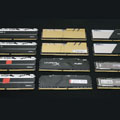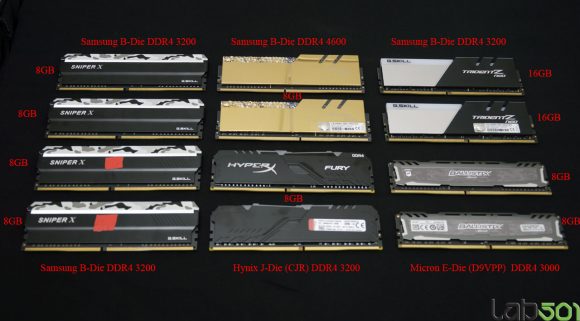AMD Ryzen 3000 DDR4 Scaling – Part II – Samsung B-Die vs Micron E-Die vs Hynix CJR – English version

Samsung B-Die vs Micron E-Die vs Hynix CJR
One of the main changes that came with the launch of the X570 chipset, along with the launch of the third generation Ryzen processors, was the way the CPU communicates with the memory. Due to the changes implemented in the Zen2 architecture, along with the X570 platform, we can now reach much higher clocks for RAM, which was hard to imagine for the Zen and Zen + generations.
For this reason, I spent a good part of July analyzing the way in which performance scales with frequency and timings, in an attempt to help you get an accurate opinion about what kind of configuration is right for this platform. The results of these tests can be consulted here, in the first part of the scaling study, which I warmly recommend you to read if you have not already done so, because that is where I explained the most important elements of the memory / processor communication process.
However, even though we published one the largest AMD Ryzen 3000 RAM scaling studies, the results of this study were based on a single type of memory, you guessed it, equipped with Samsung B-Die ICs. Basically, using the same memory kit, we tried to analyze the impact that clocks, timings, synchronous and asynchronous operating modes have on the performance, running a large number of tests.
Thus, we found that in order to achieve maximum performance we must use a 1:1 configuration with the highest clocks possible, with tight timings. Obviously, in daily use, we will not lose too much performance if we use a DDR4 3600 16-16-16 or a DDR4 3200 14-14-14 memory kit, the biggest differences being encountered in AIDA, not in games or real-life applications. Of course, the maximum performance for the AMD Ryzen 9 3900X CPU is a 1:1 DDR4 3800 configuration with tight timings – 1900MHz fClk being the highest setting where our CPU is fully stable.
However, even though we tried to offer as much information as possible regarding this subject and we hope we helped you in choosing the right memory kit, it was clear that the first part of our study did not deal with all aspects of this issue, leaving a series of questions without answer. How do RAM kits equipped with other ICs behave? How does high density RAM behave? What happens if we use 4 memory sticks?
Well, as soon as we finished the first part of the scaling study, we started working on the second part. First, we tested Samsung B-Die dual-rank memory kits, as well as memory kits equipped with Hynix CJR ICs, respectively Micron E-Die ICs, and then we published individual reviews for each kit. Then, we tested the behavior of 4 memory kits equipped with Samsung B-Die ICs, and last but not least we used a high-end memory kit from GSkill in order to hit DDR4 4800.
What you see in this article is how I spent most of this summer, testing different RAM kits, along with AMD Ryzen 9 3900X and the excellent MSI X570 Godlike motherboard. Therefor, if in the first part we tried to see which clocks and timings combinations offer the best performance, today we will see if we can use cheaper RAM in order to achieve similar levels of performance with Samsung B-Die kits. Buckle up, because this is going to be a long ride. And, of course, please excuse my english, which is obviously not my native language.

Comentarii

Great stuff! Thanks for all the hard work.
Glad you like it!
Hi, great and extensive review, thanks for take the time to do it!!!
Did you run real world tests besides AIDA to compare, for example, performance for these different kits at the same frequency?
It would be interesting from the price/performance point of view, and if it’s really neccessary to pay a lot more for b-die kits for the theoretically best performance they show in AIDA.
Thank you.
Hi,
the real life tests were ran in the first part of the scaling study (link above, on the first page), and we found out that real life performance differs much less than AIDA, so for the second part we chose the scenario that exaggerates the difference.
Fantastic job neighbours, thank you so much for such a great test! E-die is clearly a winner considering the price/perf ratio. Too bad you didn’t have 2x16GB E-die kit on your hands, I wonder how it would compete vs B-die.
Keep up the good work, greetings from Serbia!
Hi Monstru,
Thanks for the wonderful information. I am currently planning a new build and I found your tests to be extremely helpful.
Just curious, what happens if you use 16gbx4 sticks? Will 4 dual ranks on the x570 platform reduce the speeds to 2666mhz?
Thank you!
Hi Endy, glad you found our review useful. Unfortunately we did not have 4 sticks of 16GB available for testing, so I cannot answer your question.
Thank you Meteorain, glad you liked it neighbor!
Great work indeed.
Including 2x16GB E-die for comparison against B-die would have made it pretty much perfect covering everything, considering high end choise is pretty much between those two.
Though I guess 2x16GB E-die should have pretty much same difference to 2x8GB than with B-die:
Little more latency because higher number of chips being more load and likely not capable to exactly as tight everything.
But some boost to other areas from interleaving of commands with two ranks per DIMM.
It would have been almost perfect if I had 2×8, 4×8, 2×16 and 4×16 of everything, but unfortunately even for me that is a bit hard to do.
4x8GB would be of interest to those currently having 2x8GB.
But 4x16GB won’t be needed by huge majority of home users in any near future and those actually needing such amount are likely doing work and not interested on memory overclocking and risking stability.
Also would expect achievable clocks/latencies to take notable hit with two dual rank DIMMs per channel.
So such configuration likely wouldn’t be tempting for enthusiast looking to get that last drop of performance.
And by the time 64GB starts to have bigger than rounding error level market share in home use we certainly won’t be using current DRAM chips or even DDR4.
That is also true
Hello, and HUGE thanks for this amazing review.
I’m about to build a new 3700X rig with Asus Rog Strix X570-F motherboard and I’m still not sure about the memories.
I’m choosing between 16×2 G.skill 3600 Cl16 Neo Hynix with 16-19-19-39 timings VS 16×2 Ballistix Sports LT 3200 Cl16 Micron E with 16-18-18-36 timings. Which one do you think would be easier to get to a 3733 sweetspot with cl16 and the best timings?
I’ve actually ordered the G.skill Neo, but will change to Ballistix if you think it will get better timings with 3733.
Hello, HUGE thanks for this amazing review which gives a lot of insight into memories.
I’m about to build a new 3700x rig with Asus Rog Strix X570-f motherboard and I’m a bit stuck on which memory to choose so I would love a little input.
I’m choosing between 16×2 G.skill 3600 Cl16 Neo Hynix with 16-19-19-39 timings VS 16×2 Ballistix Sports LT 3200 Cl16 Micron E with 16-18-18-36 timings. Which one do you think would be easier to get to a 3733 sweetspot with cl16 and the best timings?
I’ve actually ordered the G.skill Neo, but it seems like Micron E is the way to go so I will change to Ballistix if you think it will get better timings with 3733.
Thanks!
Hi Patrik, usually GSkill should be B-Die, in which case that kit is a good choice. Wait until you get it and check the SPD. Otherwise, if you have to choose between Hynix and E-Die… go for the E-Die kit.
Thank you Monstru,
This particular kit F4-3600C16D-32GTZNC are Hynix and costs 230 EUR. They also have F4-3600C16D-32GTZN which are Samsung B-die, but they cost 370 EUR.
The 3200Mhz Ballistix Sports (BLS2K16G4D32AESB) with Micron Rev-E on the other hand only cost 180 EUR, so not only are they (likely) better than the 3600 Hynix, but they are also cheaper.
Sorry for posting twice, but I thought the first one didn’t post properly 🙂
Don’t worry about it Patrik, we approve comments manually, that is why they don’t immediately show up.
Yes, if it is the case of Hynix vs E-Die, then E-Dies are cheapper and most likely a bit better
Hello! Was there any testing done for E-Die at 16GB x 2 (32GB) vs B-die at 16GB x 2 (32GB)? Curious to know the differences if any 🙂
Hi Jobin,
unofortunately no, since we do not have a 2x16GB E-Die kit
Pingback: AMD Ryzen 3000 DDR4 Scaling – Part II – Samsung B-Die vs Micron E-Die vs Hynix CJR – English version - 1iT.ro - Stiri IT, noutati si tehnologie
Pingback: AMD Ryzen 3000 DDR4 Scaling - Part III – AMD Ryzen 5 3600X + B450 - English version - lab501
Cele mai recente stiri
Un sistem romanesc, produs de ITD Custom Works, a ajuns tocmai in Canada, la Linus Tech Tips
Scris in 11 November, 2025.
GamesCom 2025 – Thermaltake
Scris in 21 August, 2025.
GamesCom 2025 – DeepCool
Scris in 21 August, 2025.
GamesCom 2025 – be quiet!
Scris in 21 August, 2025.
GamesCom 2025 – ASRock
Scris in 21 August, 2025.
Computex 2025 – GIGABYTE – Componente
Scris in 30 May, 2025.
Computex 2025 – Noctua
Scris in 30 May, 2025.
Computex 2025 – Pro Gamers Group – Endgame Gear, streamplify, HAVN, Kolink, Nitro Concepts
Scris in 30 May, 2025.
Computex 2025 – MSI – Motherboard & VGA
Scris in 30 May, 2025.
Computex 2025 – ENDORFY
Scris in 30 May, 2025.
Syndication
Viziteaza-ne pe Facebook
Urmareste-ne pe Twitter
Vezi ce facem pe YouTube